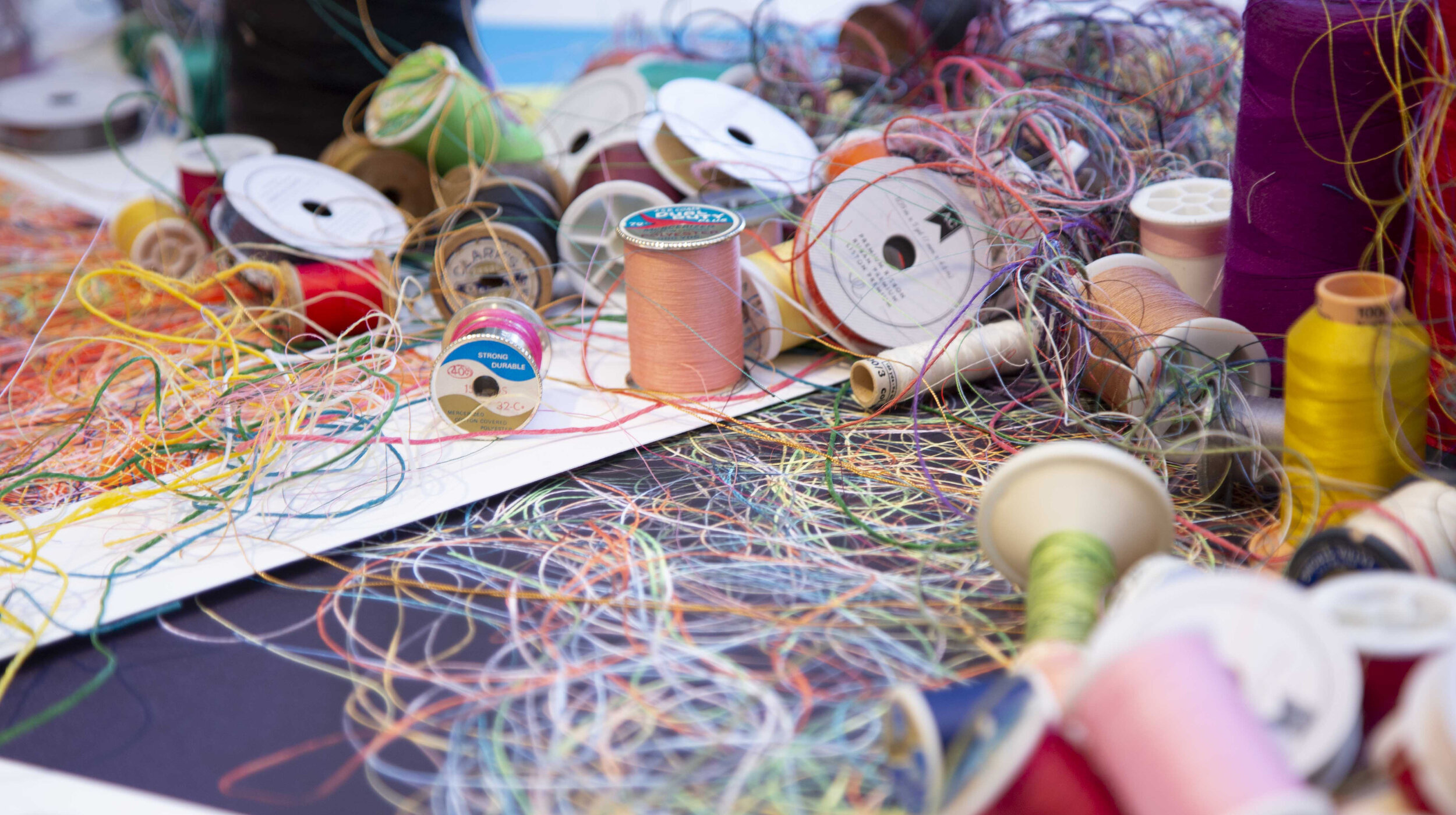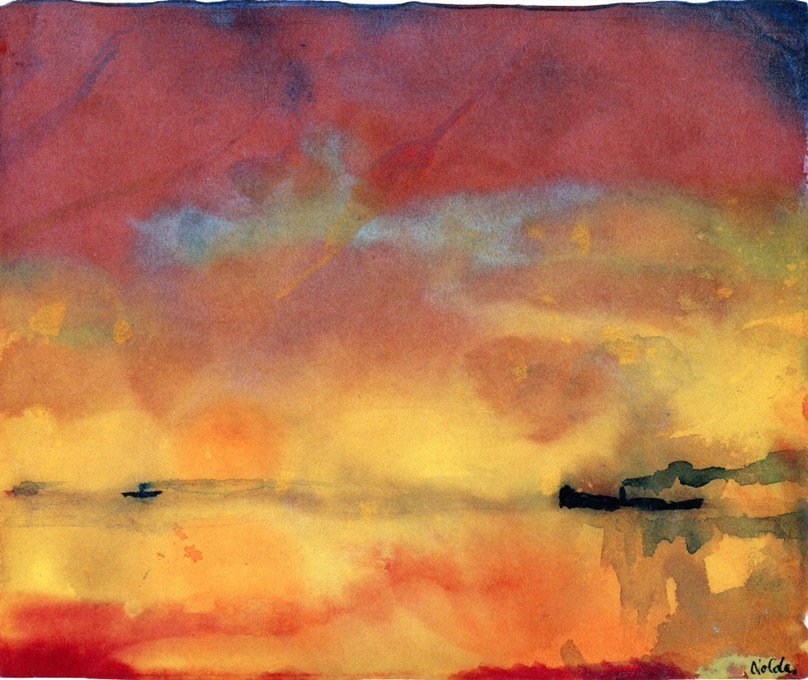
BLOG
WHEN ARTISTS’ VISION BECOMES CINEMA
In my last post, I wrote about artists whose eyesight shaped their work—Monet, Degas, O’Keeffe, Chuck Close, and others. Their paintings bear the trace of cataracts, macular degeneration, blindness, or simply a different way of seeing. But sometimes words and canvases aren’t enough—we want to see these struggles brought to life. Luckily, filmmakers have been fascinated with the same question: what happens when an artist’s vision changes?
THREAD LINES AND SPIRIT LINES
When I first saw Georgiana Houghton’s spirit drawings, I felt an instant, almost bodily recognition: Oh, she was listening to the same hum. Houghton, a Victorian gentlewoman (1814-1884), claimed that spirit guides—Titian, Correggio, and dead relatives, moved her hand. The result was a web of translucent strands, loops, and knots so intricate that even now they look as if they’ve been plotted by software. No horizon, no figure: just thread-like energy fields curling across the page.
FREQUENCIES: Painting the Invisible
When viewers walk into my new exhibition, FREQUENCY, I want them to feel as if they’ve stepped inside light itself—where color doesn’t sit politely on a surface but vibrates through the body like sound through a tuning fork. These paintings grew out of two earlier bodies of work, Unified Field and Lightness of Being, yet they push even further into that liminal territory where surface, light, and matter dissolve into one radiant continuum.
COLOR IS VIBRATION— Ask Turrell, Agnes Martin, or Anyone Who’s Stood in Front of My Paintings
When I start a canvas I’m not really mixing paint; I’m tuning a field of tiny radio stations that happen to live in the visible band of the electromagnetic spectrum. Red light hums along at roughly 620–750 nanometers—about 400 terahertz in frequency—while violet screams past at closer to 380 nanometers, almost 790 terahertz . Knowing that lets me steer feeling with a bit more intention.
BETWEEN PALETTE AND PROPAGANDA: Emil Nolde’s Troubled Dance With Nazi Germany
Nolde’s story warns that persecution alone does not equal resistance: an artist can be both victim and believer, oppressed by aesthetic policy yet thrilled by the ideology behind it. For museums and viewers, the question is not whether to hang his blazing reds and violets, but how—with letters, party documents, and wall texts that refuse the old romance of the misunderstood genius.
A SUITCASE IN THE OLIVE GROVE:Charlotte Salomon’s Fierce Waltz With History
The story starts with a battered leather suitcase, the kind that creaks when you unlatch it. Inside are 769 sheets of cheap French drawing paper, layered like stage flats: gouache scenes, penciled dialogue, and musical notes scrawled in the margins. Together they form Leben? oder Theater?—Life? or Theatre?—the autobiographical epic Charlotte Salomon painted in hiding between 1940 and 1942.
THE DELICATE UNWRAPPING: How Japonism Took Root in France
The story of Japonism in France begins, unexpectedly, with the hum of Dutch trade ships. For over two centuries, while Japan remained closed to most foreign contact under the Tokugawa shogunate’s sakoku policy, a small Dutch trading post on the artificial island of Dejima in Nagasaki Bay served as the sole Western gateway to Japanese goods. Porcelain, lacquerware, and rare silks quietly flowed into Europe, but few could imagine that humble woodblock prints, used at times as wrapping paper to cushion these exports, would one day ignite an artistic revolution.
MARGUERITE MATISSE: A Daughter's Courage in Occupied France
In dawn of the 20th century in France was marked by a vibrant and transformative artistic landscape, with the Impressionist movement having laid a fertile ground for the emergence of diverse modern art expressions.1 At the heart of this era stood Claude Monet, a foundational figure of Impressionism, celebrated for his profound ability to capture the subtle nuances of light and his dedication to exploring singular subjects through extensive series of paintings. Among his most iconic works are those depicting water lilies, a subject with which his name became intrinsically linked in the public consciousness.
HOKUSAI: A MASTER OF TWO WORLDS - HOW WESTERN ART SHAPED A JAPANESE ICON
Katsushika Hokusai (1760-1849) stands as a titan in the world of art, his iconic woodblock print, "The Great Wave off Kanagawa," instantly recognizable across cultures and time.1 His career, spanning over eight decades, yielded thousands of paintings, prints, and book illustrations, showcasing his mastery of ukiyo-e and an insatiable artistic curiosity.1 Yet, a fascinating question arises when examining his work: how did European art influence Hokusai, an artist who lived during a period when Japan was largely closed off from the Western world?
THE COLLABORATION OF CLAUDE MONET AND GEORGES CLEMENCEAU: Creating the Grand Decorations of Water Lilies for the Orangerie
In dawn of the 20th century in France was marked by a vibrant and transformative artistic landscape, with the Impressionist movement having laid a fertile ground for the emergence of diverse modern art expressions.1 At the heart of this era stood Claude Monet, a foundational figure of Impressionism, celebrated for his profound ability to capture the subtle nuances of light and his dedication to exploring singular subjects through extensive series of paintings. Among his most iconic works are those depicting water lilies, a subject with which his name became intrinsically linked in the public consciousness.
CLEMENT GREENBERG AND JACKSON POLLOCK, and a Defining Exhibition at Bennington College
The mid-20th century witnessed a seismic shift in the landscape of American art, with the emergence of Abstract Expressionism marking a departure from European traditions and establishing New York as a new global art center. At the heart of this transformative period were two towering figures: Clement Greenberg, a highly influential art critic whose formalist aesthetic shaped the discourse around modern art, and Jackson Pollock, an artistic innovator who revolutionized painting with his energetic "drip" technique
THE EASTERN WINDS IN ARLES: How Japanese Art Transformed Van Gogh's Vision
A significant and often overlooked influence on Van Gogh was the vibrant world of Japanese art, specifically ukiyo-e woodblock prints. These prints, depicting everything from serene landscapes to dramatic kabuki actors, captivated Van Gogh and fundamentally altered his artistic trajectory.
BONNARD’S JAPONISM: A DANCE OF PATTERNS AND PLANES
Pierre Bonnard, a luminary of the late 19th and early 20th century art world, was deeply captivated by the aesthetics of Japonism, the Western fascination with Japanese art and culture. While many of his contemporaries explored the bold, graphic aspects of Japanese prints, Bonnard absorbed a more nuanced, intimate understanding of the style, weaving it seamlessly into his own unique artistic vision. His paintings and prints reveal a delicate dance with Japanese aesthetics, marked by specific and recurring elements.
FOLDING WORLDS: JAPONISM AND THE DELICATE ART OF FAN PAINTING
The late 19th century witnessed a cultural phenomenon that swept across the Western art world, leaving an indelible mark on its aesthetic: Japonism. The opening of Japan to trade after centuries of isolation sparked a fervent fascination with Japanese art and design, influencing everything from painting and printmaking to decorative arts. One particularly charming and intimate expression of this influence was the practice of painting on fans, a delicate art form embraced by some of the most prominent artists of the era.
ARTISTS’ THINGS: 1929 René Lalique Gui Vase
I grew up with this Lalique vase in the entryway to our home. It was one of several pieces that my Grandmother bought in Paris in June of 1929. I know this because my father told me. The time of the purchase seemed significant as it was only a few months before THE CRASH. Later I discovered a receipt, which seems to be about the delivery of several other Lalique items — an ashtray, a box, and a perfume bottle — to her room at Hotel Crillon.
FROM GIVERNY TO ATLANTIC CITY, THE EVOLUTION OF MY BOXING PAINTINGS
Not everyone would expect that the first paintings I did after my experience at Giverny would be a series of boxing paintings, but it was.
When I returned to the States I called Teddy Atlas and asked if I could watch him train his new fighters (this was after his break from Cus d’Amato as Mike Tyson’s trainer.) One of his fighters had a fight coming up in Atlantic City and he thought I should photograph that. . .
WHAT I LOOK FOR IN A PHOTOGRAPH
Golf Juan I is a photograph of a glassed-in advertising kiosk I saw in France. It immediately struck me as a trompe l’oeil painting, with bits of tape and torn pieces of paper and the residue of glue stuck to the surface of the glass. Behind the glass is an old tourist poster faded with age. Reflected off of the glass is the village behind me, while the trees on the left are impossible to locate in space; are they part of the old poster, or a reflected part of the village? The photograph tests all our powers of perception.


















